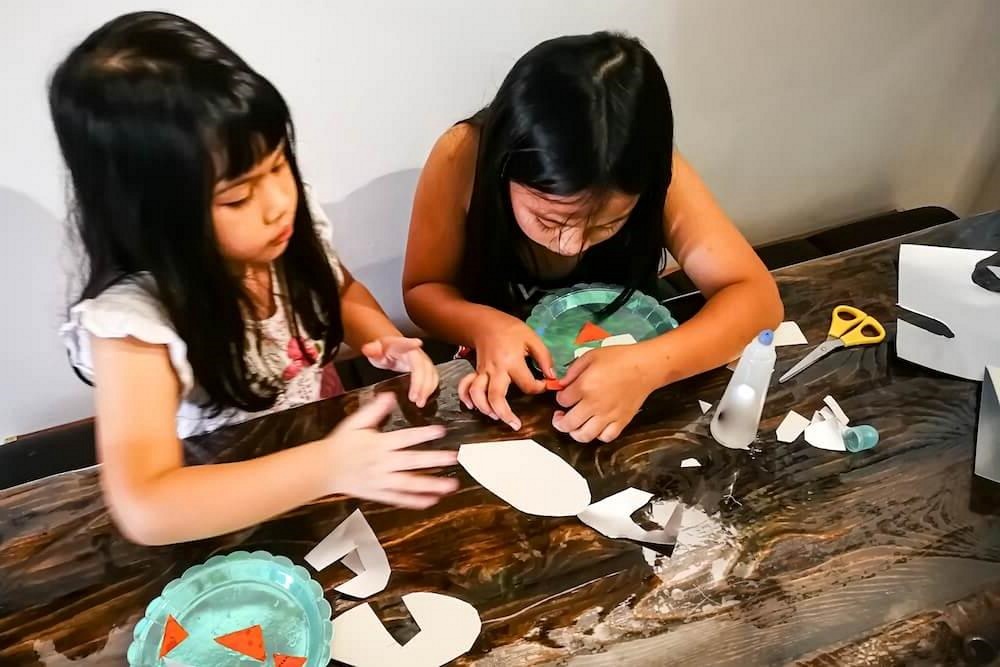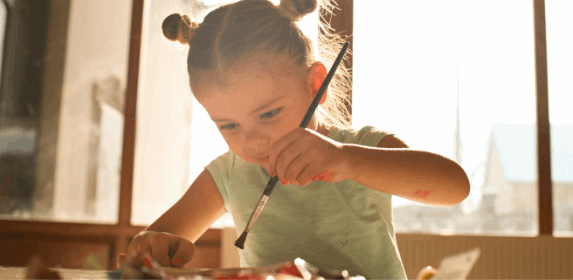An Overview of Childhood Creativity

At the core of child development is creativity, a vivid tapestry of imagination and inventiveness. It’s more than just art and music; it’s a vital talent that affects academic achievement, emotional expression, and problem-solving. Children that are creative can see the world as a rainbow of possibilities, which inspires them to think creatively and come up with original answers to problems they face.
It is everyone’s obligation to foster this creativity. In order to create an atmosphere where children’s creative spirits can flourish, parents, teachers, and the community all play critical roles. They create the groundwork for kids to explore their natural creativity by supporting them, offering a variety of experiences, and setting an example of creative problem-solving. This cooperative endeavor has a profound effect on a child’s emotional and academic development in addition to improving their capacity for self-expression.
Remember that every child is an artist in their own right as we go deeper into the principles of fostering creativity. It is our common responsibility to make sure that the colors of creativity, curiosity, and inventiveness are abundant in their palette.
Understanding a Child’s Creative Mind

Intelligent Child Qualities
- Unquenchable curiosity: a strong sense of creativity and the natural aptitude to think creatively beyond the box.
- Bright imagination: They evoke possibilities and places far beyond the real.
- Imaginative reasoning: the capacity to see beyond the obvious and make connections between seemingly unconnected pieces.
Intelligence versus Creativity
While creativity explores the world of coming up with unique ideas and cutting-edge approaches to issues, intelligence often assesses the ability to study, interpret, and apply knowledge. It is not limited by the straight lines of traditional thought. Divergent thinking, in which there are several approaches to a problem, fosters creativity and demonstrates that, despite their connections, intellect and creativity function on distinct mental spectrums.
Creativity Throughout the Stages of ChildhoodEvery stage of childhood has a different manifestation of creativity. Early on, it could involve imaginative play with toys and making up elaborate stories for their dolls or action figures. Children’s creativity changes as they become older because of their growing world knowledge. Children in school may use writing, drawing, or problem-solving as a means of expressing their creativity and sharing how they see the world. Adolescence is characterized by a deeper degree of abstraction and critical thinking, which facilitates complex creative expression and invention. Encouraging and identifying these dynamic types of creativity is essential for overall growth.
Nurturing a child’s potential requires an understanding of their creative mind. Through acknowledging the attributes of creativity, differentiating it from intelligence, and fostering its growth throughout different phases of life, we may create an environment that fosters our kids’ inventive ideas and imaginations. This not only enhances their early years but also gives them the innovative problem-solving abilities needed to succeed as adults.
Play’s Significance in Fostering Creativity

Play without rules is the soil that nurtures creativity. Through unstructured play, kids develop their ability to think creatively and consider various approaches to a given issue. Play with no set rules or expectations is essential for the growth of the creative mind. It encourages creativity and resilience in children by letting them try new things, fail, and try again.
Playing with open-ended toys, being outside, and using your imagination are all extremely effective in fostering creativity. Children learn to navigate the limitless landscapes of their imagination by becoming the architects of their own stories through imaginative play. Conversely, engaging in outdoor play exposes children to the unpredictable nature of the outside world, promoting flexibility and problem-solving skills. Children are challenged to give their own meanings and purposes by open-ended toys, or ones without a set purpose, which encourages creativity and inventiveness.
In the digital age, it’s crucial to strike a balance between screen time and active play. While there are educational resources available on technology that support learning, spending too much time in front of a screen might inhibit creativity by reducing possibilities for hands-on activities and sensory experiences. Promoting equilibrium guarantees that kids gain from the plethora of online resources without forfeiting the imaginative advantages of active, hands-on play. The Australian Department of Health offers suggestions for controlling screen time at that can support caregivers and parents in developing a balanced strategy.
In the end, play has a critical role in fostering creativity that cannot be emphasized. Children learn to perceive the world not just as it is, but also as it could be via play. We provide the conditions for our kids to grow into creative, resilient problem solvers who can think creatively and adaptably to the challenges of the future by providing them with a rich and varied play environment.
Promoting Artistic Expression via Handcrafts

Crafts and the arts are more than just pastimes; they are doors to creative and emotional growth. By participating in these activities, kids can express their emotions in a concrete way, which develops their emotional intelligence and resilience. The process of making art fosters a creative mindset that sees obstacles as chances for invention and permits concept exploration, boundary testing, and the development of fine motor skills.
Finger painting and clay modeling are great places to start for young children. Both the development of motor skills and sensory exploration are encouraged by these activities. When kids get older, introducing more difficult crafts like woodworking, basic sewing, or collage creation can fit with their developing skills and interests. In addition to encouraging creativity, these crafts impart patience, focus, and the sense of accomplishment that comes from finishing a task.
To genuinely promote creativity, give more attention to the method than the result. Instead of focusing on the finished product, honor the creativity and work that goes into each production. To get children to reflect more thoroughly on their art, pose open-ended questions to them about it, such as “Tell me about your painting.” Give them a range of tools to work with so they may experiment, make errors, and grow from them. This method teaches kids that creativity isn’t about perfection but about expression and discovery.
The ultimate objective is to establish a setting where kids may express themselves without worrying about being judged. By doing this, we help them develop their sense of self and confidence in addition to improving their creative ability. Therefore, arts and crafts are more than just pastimes; they are vital resources for raising tomorrow’s creative thinkers.
The Influence of Reading and Storytelling

Children’s imaginations and empathy are stimulated by storytelling and reading aloud, which act as enchanted doors to other realms. These educational and entertaining activities expose young brains to a variety of viewpoints and cultures. Children get a knowledge of diverse emotions and situations by putting themselves in the shoes of others and walking through the vivid landscapes of stories. Children that possess empathy are able to envision and create with sensitivity and depth, which is a fundamental component of creativity.
- Selecting literature: Seek out narratives that question accepted wisdom, pose issues for discussion, or delve into novel concepts. Rich, vivid language in books also encourages children to visualize the story and create their own mental images of it.
- Uplifting characters: Young readers can be motivated to be as resilient and inventive by stories about people who solve problems creatively or who think beyond the box.
It is equally vital to encourage kids to write and tell their own stories. Asking children to picture the next scene in a novel you’re reading together or encouraging them to make up stories based on their imaginations or experiences can be easy ways to do this. Imagination can be stimulated by giving children tale starters or ideas, but allowing kids to fill in the blanks encourages creative thinking. Celebrating their stories inspires kids to keep exploring the limitless possibilities of their imagination and celebrates their creativity, whether it is through sharing them with others or compiling a special book of their tales.
In the end, it is impossible to overestimate the importance of reading and storytelling in fostering creativity. These classic exercises help kids develop their language abilities while also laying the groundwork for a lifetime of knowledge, comprehension, and creativity. We provide children the ability to envision, empathize, and think critically by immersing them in the world of stories and encouraging them to create their own. These are abilities that will benefit them in both their academic and personal life.
Furnishing Ingenuity via Difficulties and Problem-Solving

A key component of developing creativity is promoting taking calculated risks and learning from mistakes. It instills resilience in kids by demonstrating to them that obstacles are opportunities for growth rather than a sign of failure. We enable kids to venture outside of their comfort zones and ignite boundless creativity by creating an atmosphere where taking chances is valued.
- Possibilities for artistic expression: It’s critical to provide kids the chance to use their creativity while solving difficulties. This entails giving kids problems that necessitate creative problem-solving instead of simple assignments.
- Leading through obstacles: It’s an art to help kids overcome obstacles without giving them clear answers. Achieving a balance between providing assistance and giving them room to experiment and make mistakes is crucial.
In the end, encouraging children’s creativity through challenges and problem-solving skills gets them ready for a world that prizes ingenuity and adaptation. It gives students the tools to approach the unfamiliar with curiosity and bravery, prepared to turn setbacks into chances for development and innovation.
Concluding

Childhood is essentially a creative experience. It makes every step richer by promoting resilience and joy. By providing supportive surroundings, a range of experiences, and opportunities for creative play, we help kids create the fabric that makes them uniquely they. Through the discovery of the arts, the potency of narrative, and the acceptance of obstacles, this trip equips students for a future in which creativity and adaptability will be critical. Let’s make a commitment to encouraging this creativity so that the following generation is equipped to imagine and create a world full of opportunities.
Nurturing Creativity in Children FAQs


